The spiritual leader of Kauai Aadheenam is Satguru Bodhinatha Veylanswami. He has been the monastery’s head since the founder, Satguru Sivaya Subramuniyaswami, attained mahasamadhi, his great departure, in 2001. Subramuniyaswami, known affectionately as Gurudeva, designated Bodhinatha, a disciple for 37 years, as his successor.
Most of the year finds him on the island of Kauai, where he oversees the varied publications of Himalayan Academy and serves as publisher of the international magazine Hinduism Today. At the 382-acre monastery-temple complex, he trains the younger monks in their service duties and spiritual practices, and guides the lives of hundreds of families around the globe. He officiates at major ceremonies in the monastery’s two Śiva temples and personally meets with visiting śishya and pilgrims. In April 2020, during the COVID-19 pandemic restrictions he began a weekly satsang on Zoom Video Communications with separate sessions hosted in Singapore and California Sunday morning local time. Additionally, he guides the financial and administrative staff of four major nonprofit organizations, including the twenty-five-million-dollar Hindu Heritage Endowment, for which he was the principal architect under Gurudeva’s guidance.
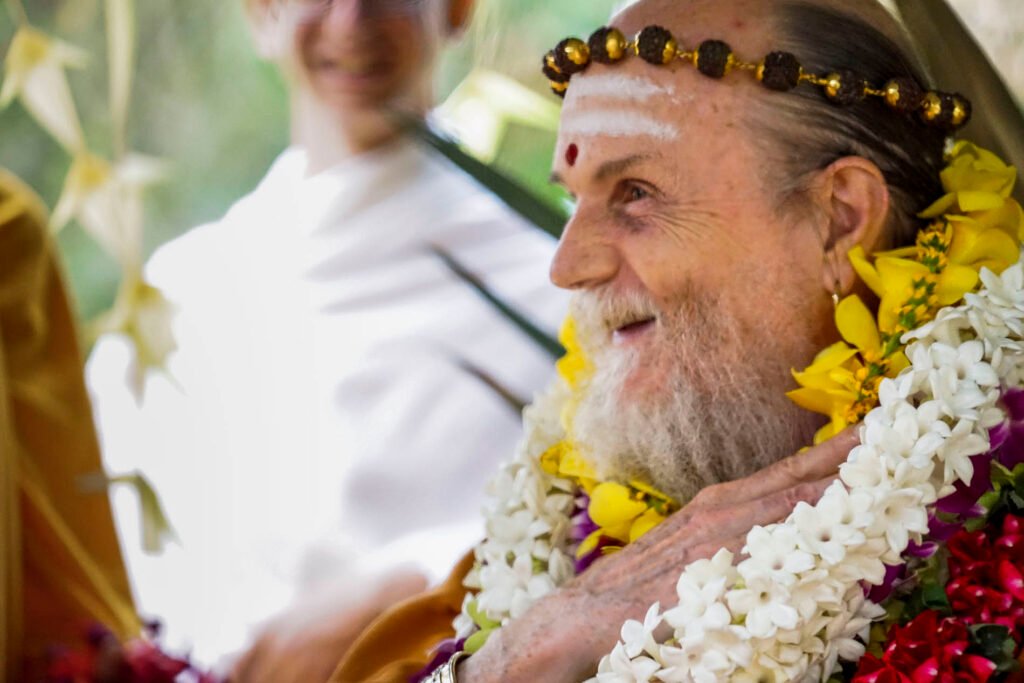
Bodhinatha travels a few times a year, teaching Hinduism and consecrating major Hindu temples around the world. He has personally blessed the openings of mandirs in North America, Australia, India, Malaysia and the United Kingdom. Communities across the United States, Canada, the Caribbean, South Asia and elsewhere have brought him to address their devotees. Every few years he conducts Innersearch Travel-Study Programs, taking pilgrims to India, Australia, New Zealand, Malaysia, Cambodia, Hawaii and, most recently, Sri Lanka.
In 2011 he was honored by the Sivacharyas of India for overseeing a three-year project that digitized over a million inscribed palm leaves to preserve and share with the world ten thousand deteriorating manuscripts, including rare Saiva Agamas and other important scriptures and texts.
In 2023 the World Hindu Congress gathered in Bangkok, Thailand to honor Satguru Bodhinatha Veylanswami as publisher of Hinduism Today. From the stage they said, “The Organizing Committee of the World Hindu Congress, 2023 Bangkok wishes to express profound appreciation for the remarkable contributions made by Hinduism Today since its establishment under the guidance of Satguru Sivaya Subramuniyaswami, a devoted disciple of Jnanaguru Yoga Swami from Jaffna, Sri Lanka.
“Hinduism Today’s commitment to nurturing Hindu solidarity, fostering unity and dispelling misconceptions about Hindu Dharma is truly praiseworthy. It has served as a guiding light of knowledge, inspiration and awakening for Hindus across the globe. The unwavering dedication to nurturing the ongoing spiritual Hindu renaissance and providing a valuable resource for Indian leaders and educators is immeasurable.
“Hinduism Today’s pivotal role in preserving and promoting the rich heritage of Hindu Dharma is deeply appreciated. We extend our heartfelt gratitude for your tireless efforts in upholding the essence of Hindu Dharma and sharing its wisdom with the world.”
The award was then personally presented by Shri Parande and Dr. Mohanrao Bhagwat, Sarsanghchalak [head] of the Rashtriya Swayamsevak Sangh.
TEACHINGS AND PUBLICATIONS
- Audio Upadeshas
- Hinduism Today Publisher’s Editorials
- Publisher’s Editorial Videos
- Books
- Educational Insights
Other Writings
ADDITIONAL BACKGROUND
Born in Berkeley, California, on October 15, 1942, Bodhinatha began studying Vedanta and meditation in 1960, soon developing a deep interest in monastic life. He met Gurudeva at the Mountain Desert Monastery in September of 1964 in Virginia City, Nevada, while still in school. At this first meeting he stated his desire to realize God. Gurudeva brought him close quickly by having him stay in the San Francisco monastery on weekends. When school was completed in June, 1965, Bodhinatha moved full time into the monastery and took his sadhaka vows a few months later in August at age 22.
Bodhinatha managed Gurudeva’s Master Course Correspondence Study from the Nevada monastery in the late 60s, guiding hundreds of students in their initial explorations of yoga, meditation, mysticism and Hindu metaphysics. He was in the initial group of four monks who moved with Gurudeva to Kauai to establish Kauai Aadheenam in February, 1970. Later that year, Gurudeva took him to Sri Lanka and introduced him to the Jaffna Saivite culture and worship. He worked closely with Gurudeva from 1970 to the present as Vice President of Gurudeva’s several nonprofit corporations and one of the stewards guiding the life of the monks, their activities, publications and projects, responsible directly for all financial, legal and administrative matters.
In March, 1972, he received sannyas diksha in a powerful ceremony at which a number of monastics were initiated by Gurudeva at his Sri Subramuniya Ashram in Alaveddy, Sri Lanka. He received from Gurudeva the name Veylanswami a few weeks later at the Murugan Temple in Palani Hills. After helping Gurudeva take 72 pilgrims on the round-the-world 1972 India Odyssey Innersearch to many temples and ashrams in India and other nations, he was sent by Gurudeva to live, meditate and do special sadhanas for six months at the Sri Subramuniya Ashram in Alaveddy. He stayed six months at the Sri Subramuniya Ashram again in 1974. During this period, totaling one year in the homeland of the Kailasa Parampara’s tradition, he was able to visit many times for worship and meditation Paramaguru Yogaswami’s hut in Columbuthurai, the Sivathondan Nilayam on KKS Road, the famous Nallur Murugan Temple, the Kumbalavalai Pillaiyar Temple, Katirgamam in the South, as well as numerous other places of worship. Though Yogaswami passed in 1964, his shishya Markanduswami was still living, and Bodhinatha was able to spend time with this remarkable direct disciple on a number of occasions.
In preparation for beginning his first teaching mission, he was directed by Gurudeva to spend nine months living in complete solitude as a hermit in a thatched hut on a small oceanfront parcel on the Kona Coast of Hawaii where he performed intense daily worship and meditation during most of 1977. Later, in 1982, he began to serve in a senior administrative capacity at Kauai Aadheenam, also accompanying Gurudeva on lecture tours to Mauritius, Malaysia and Singapore. In 1988, Bodhinatha spent six months on pilgrimage in India, spending time worshiping and meditating at ashrams and temples from as far north as Rishikesh to Tiruchendur in the South. Upon returning to Kauai, he received acharya diksha from Gurudeva, becoming the first acharya of Gurudeva’s Order.
From 1993 onwards Gurudeva entrusted to Bodhinatha the formation and development of the Hindu Heritage Endowment, which will support Hinduism and the church far into the future.
In 1995 a new version of the Church’s manual, called the Saiva Dharma Shastras, was published in which, for the first time, Gurudeva named his successors. Three were designated, with Bodhinatha being the first, followed by Palaniswami and then Ceyonswami.
Gurudeva was on retreat for three years from 1997 to 1999, absorbed in completing his legacy work, the Master Course trilogy. During those years, he vowed not to leave the island of Kauai. Therefore, Gurudeva asked Bodhinatha to represent him and to travel more frequently to the USA, India, Malaysia, Singapore and Mauritius to visit members, students and devotees. He met them in small and large groups, giving private and public talks and holding satsangs. Activities during these years included taking members and younger monks on pilgrimage to major temples in Tamil Nadu, visiting ashrams in Karnataka and spending time at our Bangalore carving site for the Iraivan Temple. In 1997 Gurudeva initiated Bodhinatha as Paramacharya, which empowered him to give the first Saivite initiation of Samaya Diksha, also known as Mantra Diksha, and gave him the name Bodhinatha, which means “lord of wisdom” or “chief among the awakened ones.” During his 1997 travels, he gave Samaya Diksha to members in Mauritius, Malaysia, Singapore and India.
In 1999-2001 Gurudeva was again traveling on month-long programs, such as the Innersearch Travel Study Programs to Alaska, the Caribbean and Northern Europe, and to the United Nations Millennium Summit of Religious and Spiritual Leaders. He was again away from his normal duties at the Aadheenam during his three month recovery from a hiking injury suffered on December 5, 2000. Bodhinatha was the senior monk in charge in Gurudeva’s absence, responsible for conducting the monks’ morning meditations, giving talks to the monks as well as presenting the semiweekly discourses in Kadavul Hindu Temple for devotees.
On October 21, 2001, the tenth evening of Gurudeva’s 32-day prayopavesha fast, Gurudeva asked Bodhinatha to come to his bedside which all the monks had gathered around. He sent for his aadheenakartar pendant, the symbol of the spiritual head of Kauai Aadheenam, then placed it lovingly on Bodhinatha’s neck. He took his beautiful golden Namasivaya bracelet and softly clasped it on Bodhinatha’s wrist. It was a gracious moment, and no one in the room missed its importance. Gurudeva then removed one of his rings and placed it on his successor’s finger stating that his name would be Satguru Bodhinatha Veylanswami, then declaring, “You are the guru now.”
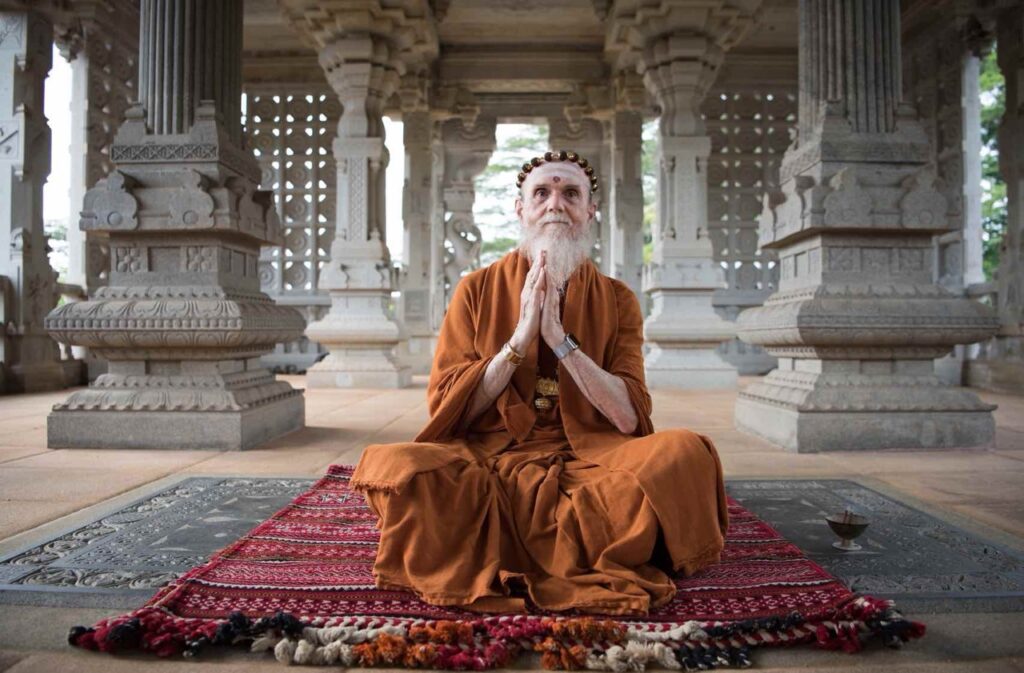
Satguru Bodhinatha Veylanswami worships in the Maha Mandapam of Iraivan Temple.
In Conversation with Satguru Bodhinatha Veylanswami
In September of 2024 Dr. Sunil Joshi, Assistant Professor of Sanskrit at the University of Delhi, engaged Satguru in a conversation that he intends to include in a book full of such encounters with spiritual leaders. It proved so interesting, we share it here.
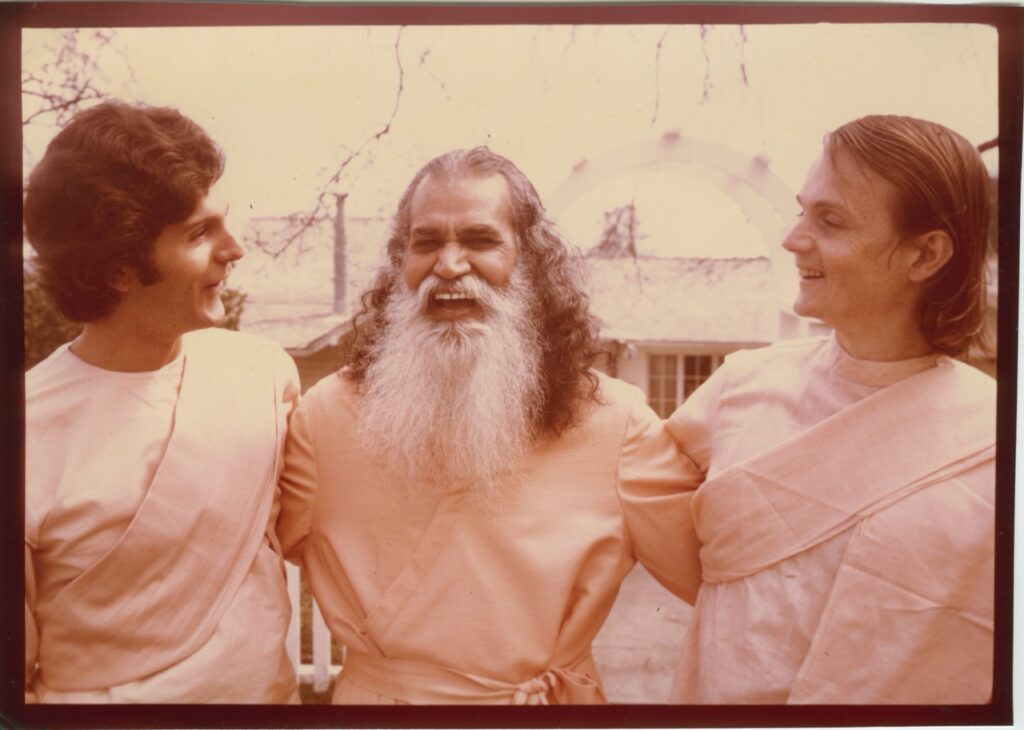
1 Satguru, could you share some insights into your early childhood experiences and what inspired you to embrace Indian culture and monastic life?
I became interested in Vedanta and meditation around the age of eighteen when living in Southern California. At that time, 1960, there were, of course, no traditional Hindu temples with priests from India and daily pujas. The only organizations in the area were the Vedanta Society of Southern California and the Self-Realization Fellowship. I read their books, attended their lectures and meditations and studied their lessons. I would say what inspired me was the accounts in their books of personally experiencing God. The story that impressed me the most was Sri Ramakrishna’s answer to the young Vivekananda’s question “Sir, have you seen God?”
In Swami Vivekananda’s recollection: Sri Ramakrishna responded, “Yes, I see him just as I see you here, only in a much more intense sense.” “God can be realised”, he went on. “One can see and talk to Him as I am doing with you. But who cares to do so? People shed torrents of tears for their wife and children, for wealth or property, but who does so for the sake of God? If one weeps sincerely for Him, He surely manifests Himself.” That impressed me at once. For the first time I found a man who dared to say that he had seen God, that religion was a reality to be felt, to be sensed in an infinitely more intense way than we can sense the world.
In 1962 I moved to Northern California and started attending the Vedanta Society in Berkeley and San Francisco. Then in 1964 I noticed articles in the religion section of the San Francisco chronicle by Master Subramuniya who had a center on Sacramento Street in the Presidio district. In September of 1964 I arranged to meet him at his Mountain Desert Monastery in Virginia City, Nevada. At this first meeting I was deeply impressed with his spiritual presence and stated my desire to realize God. Gurudeva brought me close quickly by having me stay in the San Francisco monastery on weekends. When school was completed in June, 1965, I moved full-time into the monastery and took my sadhaka vows a few months later in August at age 22.
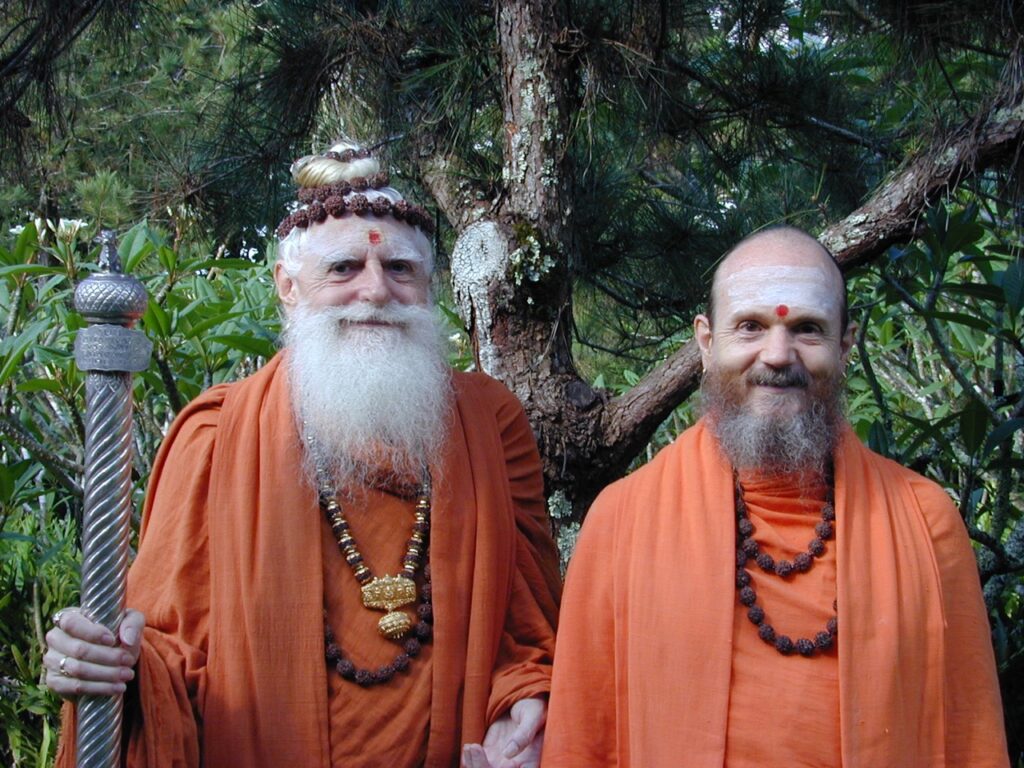
Satguru Bodhinatha Veylanswami with Sivaya Subramuniyaswami at Kauai’s Hindu Monastery.
2 Your journey as the head of Kauai Aadheenam began after the mahasamadhi of Gurudeva, Satguru Sivaya Subramuniyaswami. Could you share some of the most profound teachings of Gurudeva that continue to guide you in your leadership and spiritual mission today?
Gurudeva Sivaya Subramuniyswami placed great importance on his monastic and lay shishyas’ leading a balanced life. To help them accomplish this, he divided his lay shishyas’ life into six main areas and his monastics’ life into two main areas. I have continued this same emphasis on living a balanced life.
For the lay shishya the foremost area, of course, is the spiritual area. I encourage a daily practice, called a vigil, weekly temple attendance and yearly pilgrimage. For the other five areas, I encourage shishyas to have a plan for the next six years which they update every year during the month of Aries—considered the best month of the year for planning. Examples of goals for these five areas are:
- Social: Extended-family gatherings. Special family outings.
- Cultural: Children taking dance and music lessons. Attending cultural performances as a family. Adults taking time to paint, play music and sing.
- Economic: Saving for the children’s education. Saving for retirement.
- Educational: Children’s secular education. Adults acquiring new skills. Training to advance career. Learning about herbs, healing, making preserves; arts and crafts.
- Physiological: All health goals, diets, pancha karma and other therapies and fasting regimens, exercise and care of one’s physical environment, including clothing and hobbies, can be included in this category.
For monastics, Gurudeva divided life into just two areas. These are described in the monastic vow books: “The monastic disciplines followed in the monastery are a combination of selfless service to others and the personal practice of the sadhanas of worship and meditation. Strive always to keep the right balance between these two, not forgetting one to favor the other.”
When it comes to sadhanas for monastics, the most advanced sadhana is called nirvikalpa samadhi, the realization of Parasiva—the transcendent aspect of God. I encourage striving for this realization through including it in the monastics’ daily group meditation, which I guide each morning in our meditation hall, as well as mentioning it regularly in readings from and talks based on Gurudeva’s writings. The inner importance of this practice was described in this way by Gurudeva:
“A legacy of devas from the entire parampara accompanies our monasticorder, providing silent, unseen inner guidance and protection for old and young alike. As long as at least one person within the entire group of mathavasis (monks) is going into and coming out of Parasiva once a day, the doorway to the Third World remains open to the hereditary entourage of devonic forces that has been building up for over two thousand years. … keeping vibrantly strong the inner, actinic connection with all gurus of our parampara, as well as with other sadhus, rishis and saints who have reached these same attainments, and with the sapta rishis themselves who guide our order from deep within the inner lokas.”
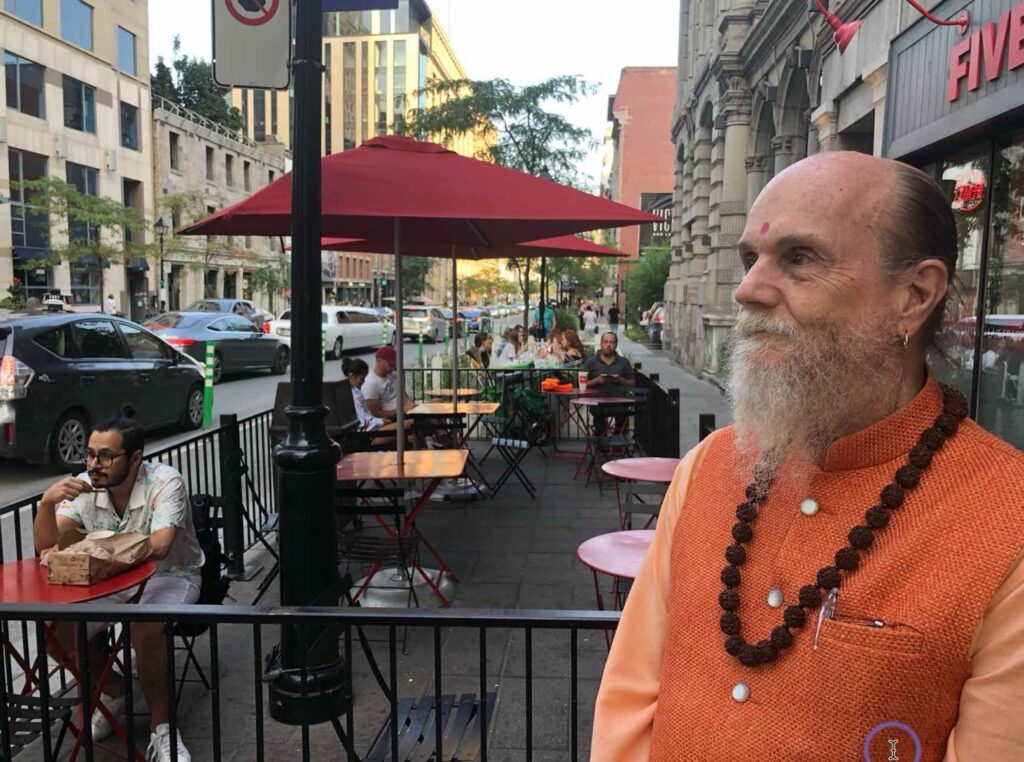
Satguru travels frequently. Here he is in Canada ca 2020 on a teaching mission.
3 Your teachings often highlight the wisdom of Vedic literature and tradition. In what ways can these ancient ethical principles be adapted to help individuals navigate and resolve the complex moral dilemmas of today’s modern world?
Let me take one ancient ethical principle and show how it can be applied to a complex modern event. After the 2001 September eleventh attack on the World Trade Center in New York, key Western leaders increasingly condemned some men as being evil and extolled others as being good. This, of course, is not the Hindu perspective. It is good to take time to reflect on the Hindu point of view regarding good and evil to make sure your thinking on the matter remains uninfluenced by Western philosophical thought regarding the nature of man. The Hindu viewpoint is that all of mankind is good; none is evil. We are all divine beings, immortal souls created by God. In fact, we are all one family; as the ancient scriptures state, vasudhaiva kutumbakam, “the whole world is one family.” This expresses the ideal that we do not identify with a part of a group but rather the whole. It seems impossible to look at those who attack us with compassion, but it is possible and it is practiced by the most spiritual among us.
Here is an exercise to apply this idea to your life. Start with yourself and add others, immediate family, distant relatives, friends, others living in your neighborhood, others in your state, others in your country, others in foreign countries. Now, who is left out? Next add them one group at a time until no one is left out and you truly feel vasudhaiva kutumbakam—the whole world is one family.
What is the Hindu philosophical basis for this idea? It is that all human beings are on a spiritual journey to moksha, whether they realize it or not, and the journey spans many lives. If all are on the same journey, why is there such a disparity between men? Clearly, some act like saints and others act like sinners. Some take delight in helping their fellow men while others delight in harming them. The Hindu explanation is that each of us started the journey at a different time. Thus some are at the beginning of the spiritual path, while others are near the end. In other words, there are young souls and there are old souls. My guru, Sivaya Subramuniyaswami, describes this in an insightful way: “People act in evil ways who are not yet in touch with their soul nature and live totally in the outer, instinctive mind. What the ignorant see as evil, the enlightened see as the actions of low-minded and immature individuals.”
In summary, when people act in evil ways we don’t condemn them as evil people but rather inwardly see them coming up in consciousness over a period of multiple lives and eventually acting in virtuous ways.

Satguru Bodhinatha Veylanswami in the sacred Kauai gardens,
holding the danda signifying the authority of the Aadheenakartar.
4 In the vast continuum of spiritual wisdom and tradition, how do you see the role of the satguru evolving to address the unique challenges of modern society?
The Sanskrit term guru has become a part of our modern secular vocabulary. For example, Wall Street has its gurus, such as Warren Buffett. In this usage, guru refers to an individual who is an expert in his or her field. The traditional meaning of guru is different from this in that it refers to a teacher, in fact a teacher of any subject, for example a dance guru. For a satguru, the subject he or she is imparting is “sat” which means Ultimate Truth or Reality.
The satguru is imparting this knowledge to disciples who are called shishyas. We can learn about the nature of a shishya by a further comparison to dance. When a dance teacher gives a concert, there may be hundreds or even thousands in attendance. However, when the dance teacher gives a class, the group will be small and required to be practicing daily. When a satguru gives a lecture, likewise the audience may be hundreds or thousands. But at his classes, the group of shishya will be small and again required to practice daily.
A significant change to the guru-shishya relationship in modern society is that shishyas are not necessarily living near the satguru. They may be in a distant country due to the significant Hindu diaspora. Or they may be living at a moderate distance and find it impractical to visit the satguru physically due to heavy vehicle traffic and long commute times. Fortunately, for both situations, we have the Internet, which satgurus are now using for virtual lectures, classes and satsangs. Courses may also be adapted to the Internet and be delivered in a learning management system (LMS) website. And, of course, the modern default form of communication between satguru and sishya is email.
Though the means of the Satguru’s presence and effectiveness have quickly evolved, the core message is the same. He is a constant reminder of their search for the Self within, giving them tools and sadhanas that inspire their progress on the Great Path.
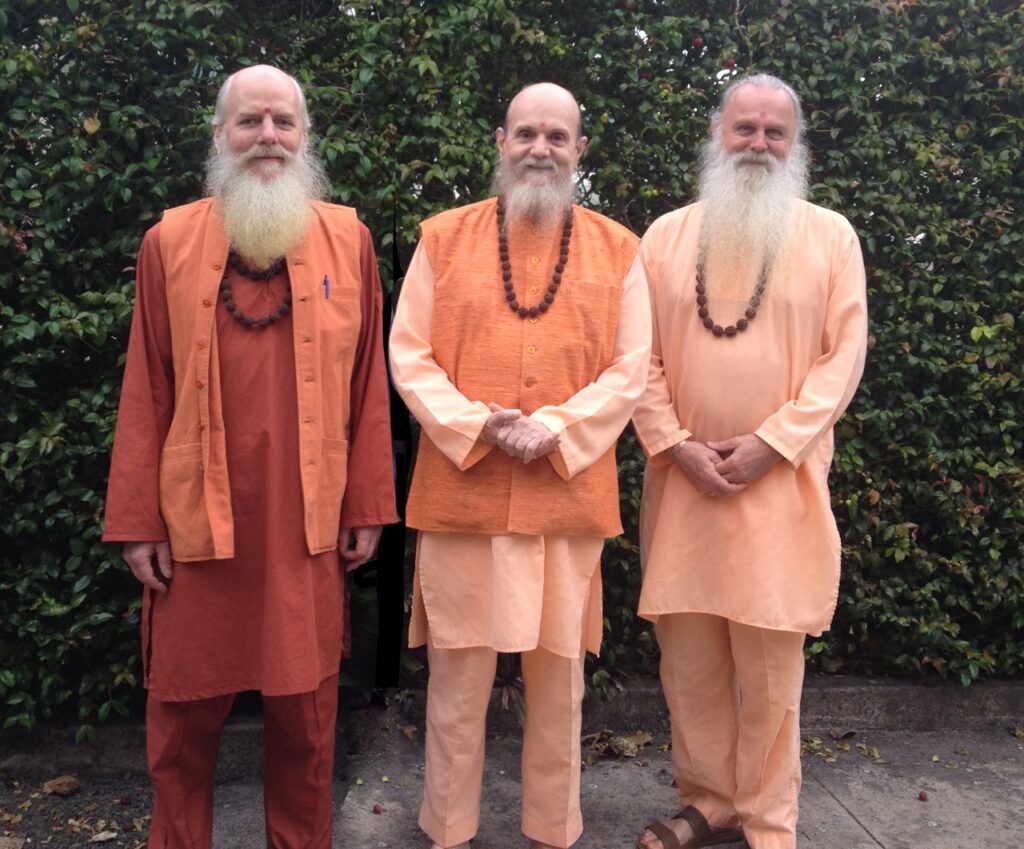
5 How does the principle of succession in the Kailasa Parampara ensure the preservation of spiritual wisdom and practices across generations?
The yoga orders that survive beyond the life of the often charismatic founder all have a spiritual successor who is regarded as the embodiment of the lineage, equal in every way to the founder. This creates a continuity of philosophical knowledge and spiritual practice that is not dependent on one person’s life and presence. Gurudeva sometimes likened this to a river which is a living, changing entity, and as the river must be renewed with the influx of new waters, so must a spiritual institution be renewed by the influx of spiritual knowing. Orders that only have administrative, but not spiritual, successors seldom live beyond a few generations. Our parampara extends back some 2,200 years.
Satguru Sivaya Subramuniyaswami created a specific plan for satguru succession which he included in the 1995 edition of our organization’s manual Saiva Dharma Shastras. The plan reads:
“In order to secure the future strength, sustenance and stability of our monastic order and our entire international spiritual extended family, I have established three successors, all very experienced in spiritual and religious matters. Each has been dear to our congregation for twenty to thirty years. All know them to be extremely competent, holy men of the highest caliber. At the time of my grand departure, the seniormost among the circle of my present three acharyas still living, those being Acharya Veylanswami, Acharya Palaniswami and Acharya Ceyonswami, will automatically become the guru mahasannidhanam, to sit upon the Kailasa Pitham, in full charge of Kauai Aadheenam, its branches and memberships, and thus carry forward the spiritual lineage of our parampara, fully empowered to give the dikshas of our lineage—samaya, vishesha, sannyasa and abhisheka. The announcement is now, and the appointment will take place automatically upon my mahasamadhi, with the coronation of the rudraksha mala upon his head happening shortly after I experience transition. It is my edict that each of the above three acharyas, who are the stewards of Saiva Siddhanta Church, Himalayan Academy and Hindu Heritage Endowment, will take his place upon the Pitham upon the grand departure of the other. This means that the next successor after Acharya Veylanswami would be Acharya Palaniswami, followed by Acharya Ceyonswami, in that order. Thereafter, seniority will not be a factor in the appointment of successors. This, therefore, is my succession plan as of 1995.”
Gurudeva mentioned a number of times that Acharya Ceyonaswami would start a new pattern of choosing his successor and that each succeeding guru would follow that new pattern. The idea is that the living satguru is the person best qualified to choose from among the monastics the one best suited to preserve the spiritual wisdom and practices of Saiva Siddhanta as taught by the founder, Satguru Sivaya Subramuniyswami.
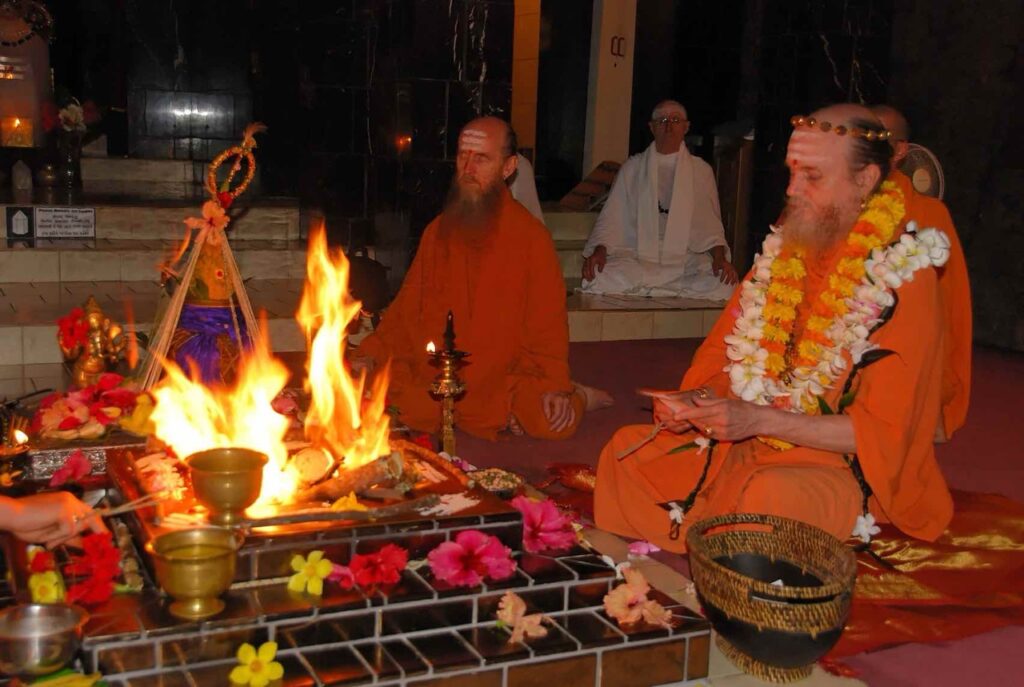
6 The Kadavul Hindu Temple is deeply rooted in traditional Sri Lankan style. How does this architectural and spiritual heritage enhance the temple’s role as a spiritual nucleus for Kauai Aadheenam?
The name of our monastery is Kauai Aadheenam. Kauai is the name of the Hawaiian island we live on, and an Aadheenam is a Saivite Hindu monastery and temple complex in the South Indian Saiva Siddhanta tradition. The spiritual nucleus of an Aadheenam is its Siva temple—a private temple where the monks themselves worship, meditate, chant, practice Sanskrit and perform personal spiritual disciplines.
As Kadavul Hindu Temple is part of a monastery, the mathavasis, or monastics, naturally form its primary priesthood. Under the aegis of the late Sivashri Dr. T.S. Sambamurthy Sivachariar, head of the South India Archaka Sangam, Adisaiva priests came to Kauai’s Hindu Monastery in the mid-1980s to train qualified monastics in the art of parartha puja, “worship for the benefit of others.” Thus, worship in Kadavul Hindu Temple carries on the form of worship found in the Siva temples of India and Sri Lanka.
The three main shrines in Kadavul Temple follow the traditional pattern of an Agamic Siva Temple. In the center is the Śiva shrine. To the left is a shrine to Lord Ganesha, and to the right is a shrine to Lord Karttikeya. These three Deities are the main Gods focused on in the personal practices of the monks and lay devotees. Outside, in front of the temple, is Lord Siva’s vahana, Nandi. There are also smaller shrines for the Trident, as protector of the temple, Ardhanarishvara and the temple’s founder Satguru Sivaya Subramuniyaswami.
In the main shrine, Siva is enshrined in two forms: a small spotless crystal Lingam and a six-foot-tall bronze murti of Nataraja. The symbolism of Nataraja’s dance visually portrays His five powers, or shaktis: 1) creation or emanation; 2) preservation; 3) destruction, dissolution or absorption; 4) obscuring grace, the power which hides the truth, thereby permitting experience, growth and fulfilment of destiny; and 5) revealing grace, which grants knowledge and severs the soul’s bonds. These five powers of God Siva are a core teaching of Saiva Siddhanta.
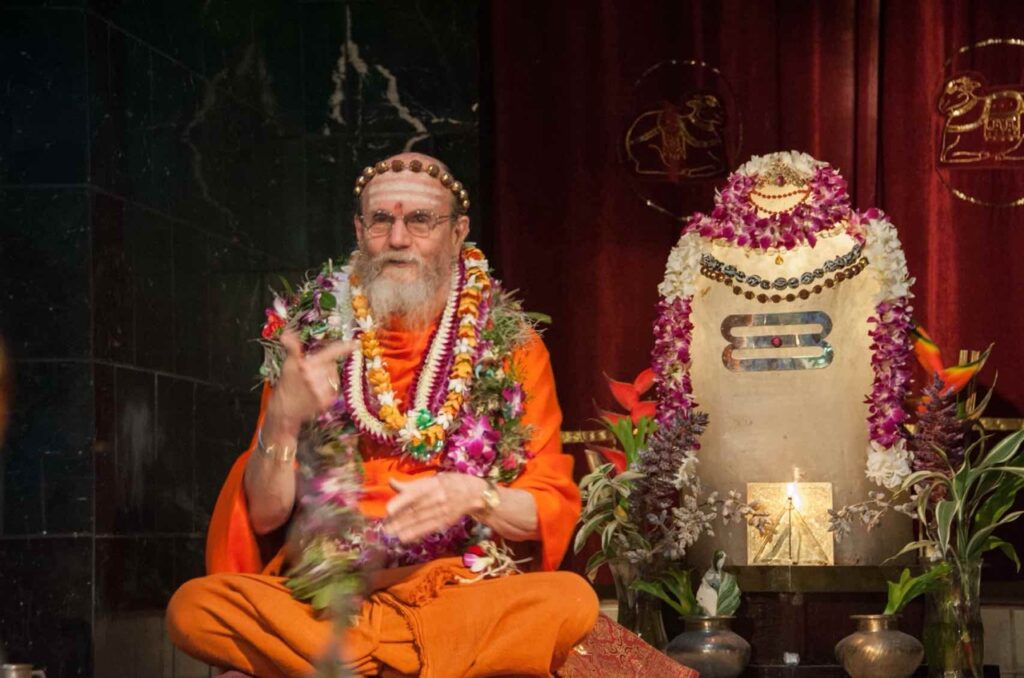
(subsequently moved to Iraivan Temple).
7 The crystal Sivalingam in Kadavul Temple is among the largest known sphatika svayambhu lingams in the world. How does the presence of such a significant sacred object impact the devotees’ spiritual experiences and practices?
The Sivalingam is the most prevalent emblem of Siva, found in virtually all Siva temples. It is the simplest and most ancient symbol of God, representing Absolute Reality, Parasiva, beyond all forms and qualities. Sivalingams are made out of different substances. A verse in the Tirumantiram (1721) gives this description:
Of crystal made is the Linga priests worship
Of gold, the rulers worship
Of emerald, the businessmen worship
Of stone is the Linga workers worship
During the 2023 consecration of Iraivan Temple by leading Sivacharyas, this Lingam was given the name Mahalingesvara. What is physically unique about the sphatika lingam, now enshrined in Iraivan Temple, is its size and shape. It is thirty-nine inches tall, weighs seven hundred pounds, is six-sided with a natural point making it the world’s largest single-pointed quartz crystal. It was discovered in a cave in Arkansas in 1975 and brought to Kauai Aadheenam in 198At. This Sivalingam was temporarily residing in Kadavul Temple until 2023, when it was moved to its permanent location as the main murti for Iraivan Temple.
Master temple architect Ganapati Sthapati designed Iraivan Temple specifically to enshrine this crystal. In an interview, Sthapati stated that the sphatika Lingam represents the akasha or space and that all the qualities of our inner being can be found embedded in it. In most temples there is a small sphatika Lingam for worship. Such a large sphatika lingam is not found in any other Siva temple. Sthapati said something else which I paraphrase here: I have been to virtually every major Hindu temple in the world during my life and I can say with confidence that if you take all of the Sivalingams of all the Siva temples they will not be equal to this one.
The benefit to devotees sincerely worshiping this remarkable lingam in Iraivan Temple is of a purely spiritual nature, providing a reinvigorating of their spiritual quest and a doorway to direct experience of Siva.
Satguru Sivaya Subramuniyswami gave this description of the process: “This means that being in the presence of its sanctum sanctorum (which houses the sphatika lingam) brings the pilgrim closer to freedom from rebirth on this planet. The vibration of the temple wipes away the dross of the subconscious vasanas and simultaneously heals the wounds of psychic surgery. It takes away encumbrances and releases the pristine beauty of the soul. As pilgrims leave the San Marga Sanctuary, they are escorted back the way they came, along San Marga and through the Rudraksha Meditation Forest with a new self-image and clear understanding of the purpose of life on planet Earth.”

8 Kauai Aadheenam is renowned for its deep commitment to preserving and sharing sacred texts. Could you discuss the significance of the digitization project that preserved over a million palm leaf manuscripts, and how this initiative impacts the global Hindu community?
One of the reasons temple worship is not better understood is that the scriptures that describe temple worship, which are called the Agamas, are not well known by the general Hindu public. They are mainly studied by priests and scholars. My guru was initiated into the Saiva Siddhanta tradition in 1949 in Jaffna, Sri Lanka, by the renowned Satguru Yogaswami. Unlike many modern teachers of Hinduism, Subramuniyaswami placed great emphasis on establishing temples. He was instrumental in the building of 37 temples around the world.
In researching the Saiva Agama texts—the Agamas that relate to our tradition, Saiva Siddhanta—we determined that the largest collection was stored at the French Institute of Pondicherry, a hundred miles south of Chennai. This institute was founded and directed by the late Dr. Jean Filliozat, whose goal was to collect all material relating to the Saiva Agamas. During the late 1950s and throughout the 60s, the late Pandit N. R. Bhatt spearheaded the collection effort. Bhatt, a scholar of the French School and former head of Indology at the Institute, gathered manuscripts from the private collections of priests and monasteries across Tamil Nadu and parts of the southern districts of Karnataka.
The bulk of the IFP’s collection comprises manuscripts of Saiva Agamas, commentaries thereon, Saiva ritual manuals, ritual compendia, handbooks, notes of Saiva priests and Tamil texts treating the doctrines of the Saiva Siddhanta tradition. This is the largest collection of Saiva Siddhanta manuscripts in the world, and it has duly been recognized by UNESCO by including it in its “Memory of the World” Register.
However, a new insight developed after our visit there in 2005 as the manuscripts unfortunately showed significant deterioration. Many were perforated with holes left by insect larvae. Others had become so fragile that each handling caused damage; pieces would break off, often carrying fragments of writing. Furthermore, the French Institute itself had no plans for preserving them. Over the coming decades, unless something changed, more and more of the manuscripts would simply fall apart and be lost forever. The realization that no one was going to do this crucial preservation work led us to decide that we, ourselves, needed to take on the project of digitization.
In December of 2008 we hired and trained four young men to do the work and process the photos. They averaged 2,000 photos daily and completed the collection (save 200 heavily damaged bundles) on January 1, 2011. Altogether, they took 775,261 photographs. These have been assembled into PDF files, one for each bundle, which are available for download on the Institute’s website—possibly the first of India’s ancient manuscript collections to be entirely digitized. A second digitization project, completed a few months later, has preserved 1,600 manuscripts at the sister institution the French School of the Far East. At a gathering of fifteen senior Sivacharyas in Chennai in July 2011, a hard drive with the digitized material was presented to each, giving back to them their sacred scriptural heritage in easily accessible form.
As to the significance of this digitization project, it kept these manuscripts from being lost through total deterioration of the palm-leaf versions. Secondly, by placing the digital files on a hard drive it has enabled them to be given to key priest training schools and academic institutions, some of whom are actively using them to produce critical editions and translations of key texts.
As to how this initiative impacts the global Hindu community, certainly it shows that digitization projects of important Hindu palm-leaf manuscripts can be done on a modest budget and staff and does not require large grants and staff to be accomplished.

on the entry steps to Iraivan Temple, 2023.
9 The San Marga Iraivan Temple, with its intricate granite carvings, represents a significant spiritual and architectural achievement. How does the construction and presence of this temple reflect the values and aspirations of Saiva Siddhanta?
A value of supreme importance in Saiva Siddhanta is the personal experience of God. And the places where such visions were experienced are revered as sacred. Sometimes a shrine or temple will be built to perpetuate the sanctity of the place. Such is the case for the San Marga Iraivan Temple. It was February 15, 1975, and here is the story of that founding vision. “Gurudeva was in his room at Kauai’s Hindu Monastery in a state of deep sleep. He was in one of those profound states of slumber that are neither awake nor full of dreams, his conscious mind fully absent. In this clear space above physical consciousness the 48-year-old satguru experienced a three-fold vision that would be the spiritual birth of the great Siva citadel called Iraivan Temple, and its surrounding San Marga Sanctuary. Here is the description of this powerful vision in Gurudeva’s own words. “One early morning, before dawn, a three-fold vision of Lord Siva came to me. First I beheld Lord Siva walking in a valley.” “Then I saw His face peering into mine.” “Then He was seated on a large stone, His reddish golden hair flowing down His back.” “Upon reentering earthly consciousness, I felt certain that the great stone Siva was sitting on was somewhere on our monastery land and set about to find it.”
Gurudeva found the stone on our property and every day since his powerful vision of Lord Siva, the Swayambhu Lingam (the stone) on San Marga has received a daily puja from the monastics at the Aadheenam. In this way, the spiritual vibration of the vision has been preserved over the decades. The Iraivan Temple was built nearby and is now drawing on the vibration of the stone Lingam and over the years will intensify it.
Certainly, a major way in which Iraivan Temple reflects the values of Saiva Siddhanta is that there is only one shrine, and it is to God Siva. In fact, every image in the temple is an image of God Siva. Let me share a story to illustrate. In June 2007 an article on the temple was released on Associated Press news service, the largest news service in the US, and published in over one hundred major newspapers in North America plus a few in other countires. The article reads: “In a clearing within Kauai Aadheenam’s lush gardens, the ping, ping, pinging of metal chipping at stone can be heard over the sounds of bird calls. A half-dozen artisans from South India put the finishing flourishes on the Hindu monastery’s legacy for the ages. “Hand-carved in granite and shipped in pieces to the island from India, the Iraivan Temple is faithful to the precise design formulas defined by South Indian temple builders a thousand years ago. The $8-million temple to the God Siva is the first hand-carved all-stone Hindu temple outside of India, according to the Kauai monks. The project is a rarity even in India.”
The article was a positive and generally accurate, which is unusual as major newspapers and news services tend to be somewhat skeptical or critical of Hindu activities. However, one phrase in the article caught my attention: the statement that Iraivan is a temple to the God Siva. This wording, unfortunately, makes Siva just one of many Gods. A better wording would be, “This temple is to God, whom this denomination of Hindus calls Siva.” In fact, the temple’s name, Iraivan, is an ancient Tamil word that names the Supreme Being as “He who is worshiped.”
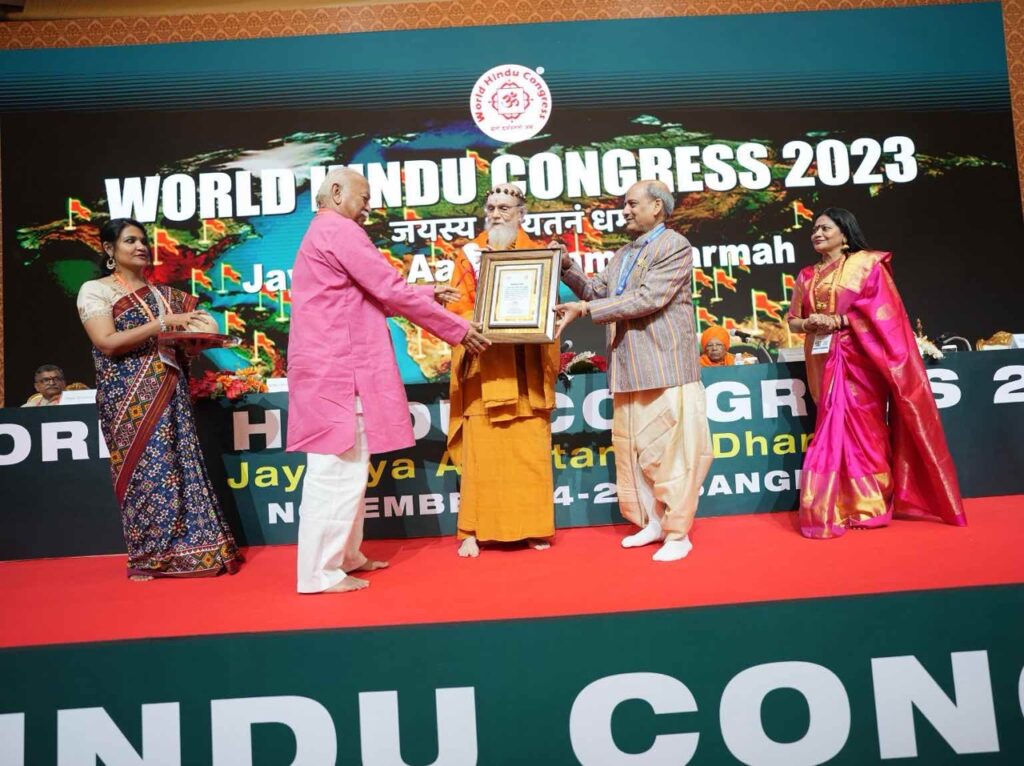
10 Hinduism Today magazine has become a significant voice for the global Hindu community under your guidance. How do you see the role of media and publications in preserving and promoting Hinduism in the modern world?
The information age, which began around the 1960s to 1970s, is now in full bloom. With the Internet and its 200 million active websites and almost a dozen major social media channels there is a plethora of information on all subjects, including Hinduism. Unfortunately, when it comes to Hinduism, the information is often not accurate. There is an abundance of innocent misinformation as well as some deliberate disinformation. With this in mind, a primary role of Hindu media and publications is to provide a source of authoritative and accurate information on the religion. We see our own publications as a trusted and authentic counterbalance to all the nonsense out there.
A second point is that Hindu media can present material in such a way that it is perceived by the reader as relevant to the modern world and not as something that existed three thousand years ago and has no relevance at all to modern life. One way that our magazine, Hinduism Today, does that is by including opinion articles from teenagers and young adults that share their application of Hinduism in their daily life. Also we share the stories of all the Hindu ashrams and leaders, stories from all over the globe which are compiled in no other place we know of. This tells the world that Hinduism, representing fully one-sixth of the human race, is alive and well, culturally rich, artistically adept, musically gifted and spiritually unrivalled.
Hindu media can also share the success of one organization’s or country’s educational or anti-conversion program to make other groups and countries aware of these efforts and thereby learn and improve their own programs. Hindu leaders can contribute articles that address contemporary issues, such as being spiritual but not religious (SBNR), the idea of secular humanism as an alternative to religion, the promotion of atheism in universities, the academic challenge that humanity no longer needs religion, and the relationship of yoga to its Hindu roots. Clearly, some Hindu concepts developed thousands of years ago need to be redefined for our modern life. For example, Hinduism Today has done this by including articles that modernize the concepts of the vanaprastha and sannyasa ashramas, and by taking the cultural gems of India out of the museum of the mind into the 21st century. “Media,” of course, means many things these days, and the Hinduism Today team continues to actively create apps, YouTube videos, spiritual art, educational documentaries, children’s stories and more that are meant to amplify the global influence of the magazine.